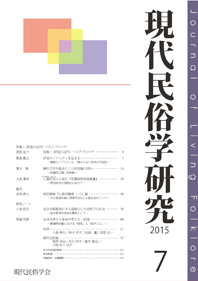『現代民俗学研究』について > 第7号目次および論文要旨
第7号(2015年3月付) 122頁
 ・『現代民俗学研究』第7号は2015年4月より頒布開始しました。
・『現代民俗学研究』第7号は2015年4月より頒布開始しました。目次
特集・〈妖怪の近代〉へのアプローチ
渡部 圭一 特集・〈妖怪の近代〉へのアプローチ
飯倉 義之 妖怪のリアリティを生きる―複数のリアリティに〈憑かれる〉研究の可能性―
清水 潤 鏡花文学を起点とした妖怪論の試み―泉鏡花が描く妖怪像―
大島 清昭 心霊研究(サイキカル・リサーチ)から見た『死霊解脱物語聞書』―妖怪研究の国際化に向けて―
論文
宮崎 靖士 柳田國男『山島民譚集(一)』論―その論説形態と同時代状況との接点をめぐって―
研究ノート
小池 高史 自治会報紙面にみる高齢化した団地での生活―東京都神代団地を事例として―
加藤 秀雄 生活世界から生命を考える・試論―動植物供養における「個性」と「殺すこと」―
研究会記録/学会記録/年次大会発表要旨
飯倉 義之 IIKURA Yoshiyuki
pp. 5-14.
妖怪のリアリティを生きる―複数のリアリティに〈憑かれる〉研究の可能性―
キーワード:妖怪研究 リアリティ フィールドワーク 認識論 民俗誌
清水 潤 SHIMIZU Jun
pp. 15-28.
鏡花文学を起点とした妖怪論の試み―泉鏡花が描く妖怪像―
キーワード:近現代文学 妖怪存在 超自然的 泉鏡花 「高野聖」 「眉かくしの霊」
大島 清昭 OSHIMA Kiyoaki
pp. 29-42.
心霊研究(サイキカル・リサーチ)から見た『死霊解脱物語聞書』―妖怪研究の国際化に向けて―
キーワード:心霊研究 妖怪研究 国際化 超常現象 霊媒
宮崎 靖士 MIYAZAKI Yasushi
pp. 43-58.
「柳田國男『山島民譚集(一)』論
On Santo Mintan Shu Volume 1 by Kunio Yanagita: Point of Contact between the Form of Description and the Contemporary Social Situation
キーワード:柳田國男 『山島民譚集(一)』 論説形態 同時代状況 伝説
要旨
本論では、『山島民譚集(一)』の特色が、ある伝説の変遷に関して、それを複数の伝承や信仰の相互関連によるものとし、かつそれらの連関を偶然的なものとしつつ、更に巫祝や呪術に関わる職業者による媒介を含む特定の条件のもとで展開したものとして記述する点に求められることを、その論説形態の検討から明らかにした。そのようなテキストの特質を、日露戦争以降、愛国心や郷土愛の涵養への要請を背景として行われた伝説蒐集事業、及び国民性の究明を目的とする芳賀矢一における伝説研究の傾向と対照した。すると、上述のような論説は、伝説の過去と現在と未来の間に、いわば継続する本質を保証しないものであり、例えば現在の立場や視点を投影することで過去の伝説の姿を理解し、過去と現在の「日本人」の間に継続する本質を見出すことを困難にしていることがわかる。そのような言説は、「日本」における歴史的な事象を対象としつつ、過去と現在の間の同質性を前提とする愛国心や郷土愛の涵養へと短絡的には収束しない、広義の文化史に関わる研究領域を開拓する試みとして理解できた。
Abstract
In this study, I demonstrate, by analysis of its form of description, that the character of Santo Mintan Shu Volume 1 was, with respect to the transition of legends, formed as the result of combining several pieces of folklore and religious beliefs. This is based on my belief that the association of these two elements happened contingently, and was developed under circumstances that included intermediation by shaman or mages magicians. I compare the character of the text of Santo Mintan Shu with the author’s project of gathering legends based on the background of social request for fostering love for home and nation following the Japanese-Russo War; and studies of legend by Yaichi Haga that aimed to determine the Japanese national character. Consequently, I found that such descriptions do not assure a continuous essence through the past, present and future of a legend. For example, understanding a legend by casting the light of a present standpoint and viewpoint makes it difficult to find a continuous essence between past ‘Japanese’ and present ‘Japanese.’ Such a description is understood as being an attempt to open a new field of study regarding cultural history in a wide meaning, not a shortsighted one focusing on fostering love for home and nation based on an assumption of the homogeneity of past and present by treating historical events in ‘Japan’ as objects of study.
小池 高史 KOIKE Takashi
pp. 59-68.
自治会報紙面にみる高齢化した団地での生活―東京都神代団地を事例として―
Life in an Aged Housing Complex Described in Community Papers: Case Study of Jindai Housing Complex
キーワード:高齢者 団地 自治会報
要旨
1950年代から70年代にかけての日本の高度経済成長期には、地方から都市部へ多くの労働者が移住した。それに伴い、都市部は深刻な住宅不足に陥った。この課題に対して、当時多くの住宅団地が建設された。当時から40~60年経過した現在、団地住民の多くは高齢者となっている。本稿では、東京都神代団地を事例として、自治会報から読み取れる現代の団地での生活について検討した。とくに団地の年中行事、高齢化を反映した自治会の取組み、他の住民への苦情に焦点をあてた。現代の団地住民の生活様式は非常に多様化していた。一方で、かつては家庭内で行われていたと予想される行事が住民共同で実施されてもいた。それらはこれまで顧みられてこなかった現代の住宅団地における生活像である。
Abstract
During the period of rapid economic growth in Japan (1950s -1970s), many workers from the countryside moved to urban areas. Due to this, there was a lack of residential homes for such workers. In order to tackle this issue, many housing complexes were built. Today, after 40 to 60 years many of their residents have become elderly. In this paper, lives of residents in a current housing complex described in community papers was examined from the case study of Jindai housing complex, Tokyo. Annual events in the housing complex, activities of the residents’ association for the elderly and complaints to other residents were focused. Lifestyles of the residents of the current housing complex are very diverse. On the other hand, activities and events which were done at home once are carried out jointly in the housing complex. They are figures of lives in current housing complexes which have been neglected so far.
加藤 秀雄 KATO Hideo
pp. 69-80.
生活世界から生命を考える・試論―動植物供養における「個性」と「殺すこと」―
Tentative Consideration about the Life from the Viewpoint of Life World: “Individuality” and “Killing” in a Memorial Service for Animals and Plants
キーワード:動植物供養 殺生 供犠 神・人・自然 生命観
要旨
本研究ノートは高木大祐著『動植物供養と現世利益の信仰論』を用い,現代社会における「生命」に対する考えを明らかにしようとするものである。日本には動植物,および筆・針・鋏などの道具に供養をおこなう民俗文化が存在する。高木の著書のテーマは動植物に対する供養と生産活動の関係性を論じることであり,猟師,造園業者,漁師などがおこなう動植物供養に着目しながら,彼らが動植物の「個性」を発見することが供養をおこなう原因になっていると指摘している。彼らは仕事のなかで動植物を殺すが,そのとき動植物の個性が浮かび上がってくるのである。
本研究ノートでは,高木と異なる視点から「個性」が生じる原因を論じ,現代社会のなかで「殺すこと」がどのような位置づけを持っているのかということを「供養」と「供儀」の違いにも注目しながら明らかにする。
本研究ノートでは,高木と異なる視点から「個性」が生じる原因を論じ,現代社会のなかで「殺すこと」がどのような位置づけを持っているのかということを「供養」と「供儀」の違いにも注目しながら明らかにする。
Abstract
This paper considers the idea to life in modern society using Daisuke Takagi’s Faith in “a memorial service for animals and plants” and “benefits gained in this world.” A memorial service for animals and plants as well as used brushes, old needles, old knives and so on is held in Japan as a folk culture. This Takagi’s work is arguing relation between “a memorial service for animals and plants” and an occupation, and he has indicated that a memorial service is held when a hunter, a gardener or a fisherman find the “individuality” in animals and plants. Although they kill animals and plants at work, “individuality” emerges when they do so.
I discussed “individuality” in a different viewpoint from Takagi’s work in this paper. I clarified what kind of positions “killing” have in modern society in relation to the difference between “a memorial service” and “sacrifice”.
I discussed “individuality” in a different viewpoint from Takagi’s work in this paper. I clarified what kind of positions “killing” have in modern society in relation to the difference between “a memorial service” and “sacrifice”.